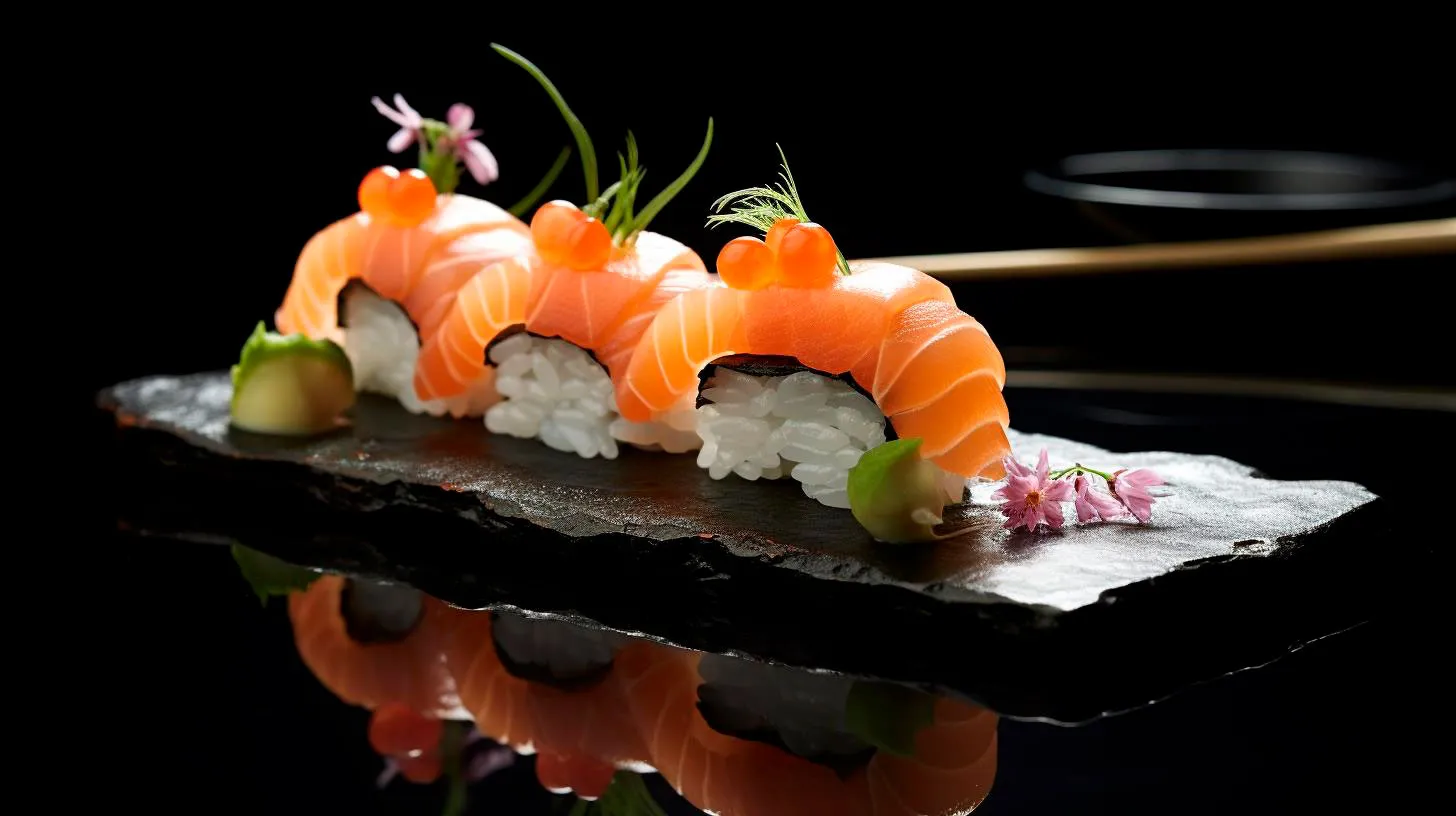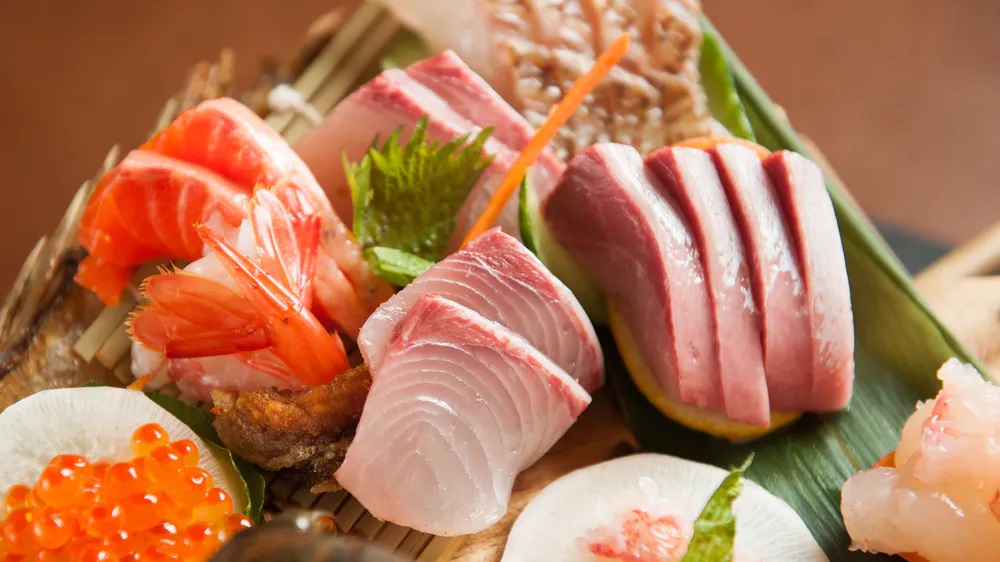A Dive into the World of Sashimi: Beyond the Raw Fish
Related Articles
- Sushi: More Than Just Raw Fish
- A Deep Dive Into The World Of Samosas: From Humble Origins To Culinary Delights
- Laksa: A Culinary Journey Through Malaysia’s Flavors
- A Slice Of Sunshine: The All-American Key Lime Pie
- A Culinary Journey: Mastering The Art Of Paella
Introduction
Join us as we explore A Dive into the World of Sashimi: Beyond the Raw Fish, packed with exciting updates
A Dive into the World of Sashimi: Beyond the Raw Fish

Sashimi, the art of thinly sliced raw fish, is more than just a dish – it’s a cultural experience. It’s a celebration of freshness, an appreciation for delicate flavors, and a testament to the meticulous skills of Japanese chefs. But beyond the simple image of raw fish on a plate, there’s a world of complexity waiting to be explored. This article will take you on a journey through the fascinating world of sashimi, revealing the secrets behind its preparation, the variety of its ingredients, and the endless possibilities for creating your own culinary masterpieces.
Understanding the Essence of Sashimi
Sashimi, literally meaning "pierced body," refers to thinly sliced raw fish, often served with soy sauce, wasabi, and pickled ginger. Its origins can be traced back to the Edo period (1603-1868) when fishermen would preserve their catch by slicing it thinly and dipping it in salt. This simple practice evolved into a culinary art form, with chefs meticulously selecting the freshest fish, employing precise cutting techniques, and crafting intricate presentations.
The Art of Selecting the Right Fish
The foundation of any great sashimi dish lies in the quality of the fish. Japanese chefs prioritize freshness, using only fish caught within the day or sourced from reliable suppliers. The most popular fish for sashimi include:
-
Tuna (Maguro): The king of sashimi, tuna boasts a rich, fatty flavor and a firm texture. Different parts of the tuna are prized for their unique qualities:
- Akami (lean tuna): Offers a delicate, clean flavor.
- Chutoro (medium fatty tuna): Has a richer, more buttery taste.
- Toro (fatty tuna): Known for its melt-in-your-mouth texture and intense flavor.

-
Salmon (Sake): Known for its vibrant orange hue and buttery, slightly sweet flavor.
-
Yellowtail (Buri): Offers a firm texture and a delicate, slightly sweet flavor.
-
Sea Bass (Suzuki): Has a mild, slightly sweet flavor and a delicate texture.

Snapper (Tai): Prized for its firm, slightly sweet flesh and beautiful white color.
-
Mackerel (Saba): A more flavorful option with a slightly oily texture.
-
Swordfish (Kajiki): Has a firm texture and a rich, meaty flavor.
-
Octopus (Tako): Offers a chewy texture and a slightly sweet, briny flavor.
-
Scallops (Hotategai): Known for their tender, sweet flavor and delicate texture.
-
Shrimp (Ebi): Offers a sweet, delicate flavor and a firm texture.
Beyond the Basics: While these are the most common choices, the world of sashimi is constantly evolving. Chefs are experimenting with new fish varieties, creating innovative combinations and pushing the boundaries of traditional techniques.
The Importance of Proper Fish Preparation
Once the fish is selected, it’s crucial to prepare it with utmost care. This involves:
-
Cleaning and Filleting: The fish is meticulously cleaned, removing scales, bones, and any undesirable parts. The filleting process requires precision, ensuring that the fish is sliced into thin, even pieces.
-
Aging: Some fish, like tuna, benefit from a short aging period, which allows the flavors to develop and the texture to become more tender. This process involves storing the fish in a controlled environment for a specific duration.
-
Slicing: The most crucial step in sashimi preparation is slicing the fish. Japanese chefs use specialized knives, known as "sashimi knives," to create thin, uniform slices. The angle and pressure applied during slicing play a crucial role in determining the final texture and appearance of the sashimi.
-
Presentation: Sashimi is an art form, and presentation plays a vital role in enhancing the dining experience. The slices are arranged aesthetically on plates, often with garnishes like thinly sliced ginger, wasabi, and edible flowers. The arrangement of the slices, the use of colors, and the overall presentation are all part of the culinary artistry.
The Art of Pairing Sashimi with Accompaniments
Sashimi is traditionally served with a trio of accompaniments:
-
Soy Sauce (Shoyu): A fermented soy sauce with a salty, umami flavor that enhances the fish’s natural taste.
-
Wasabi (Wasabi): A pungent, green paste made from the wasabi plant. It adds a spicy kick to the sashimi and is often used as a condiment.
-
Pickled Ginger (Gari): Thinly sliced ginger pickled in a sweet and sour brine. It acts as a palate cleanser, refreshing the taste buds between bites of sashimi.
Beyond the Basics: While these accompaniments are considered essential, chefs are increasingly experimenting with other flavor combinations. Citrus juices, ponzu sauce, and sesame oil are just a few examples of alternative seasonings that can add depth and complexity to sashimi.
Mastering the Art of Sashimi at Home
While sashimi preparation may seem intimidating, with a little practice and the right tools, you can create delicious sashimi at home. Here are some essential tips:
-
Choose Fresh Fish: Always prioritize freshness when selecting fish for sashimi. Look for fish with bright, clear eyes, firm flesh, and a mild, fresh smell.
-
Proper Storage: Store fish in the refrigerator at a temperature of 32-38°F (0-3°C). Fish should be wrapped tightly in plastic wrap or placed in an airtight container.
-
Invest in a Sharp Knife: A sharp sashimi knife is essential for creating thin, even slices. If you don’t have a sashimi knife, a sharp chef’s knife will suffice.
-
Practice Slicing: Slicing fish for sashimi requires practice. Start by practicing with a piece of fish that you won’t be eating. Focus on creating thin, even slices with a consistent angle.
-
Presentation Matters: Even if your sashimi slicing skills are not perfect, a little effort in presentation can make a big difference. Arrange the slices aesthetically on a plate, adding garnishes like ginger, wasabi, and edible flowers.
Exploring the Diverse World of Sashimi Dishes
Sashimi is not limited to simply slicing raw fish and serving it with soy sauce, wasabi, and pickled ginger. There are countless variations and combinations that showcase the creativity and culinary artistry of Japanese chefs.
-
Sashimi Moriawase: A platter of assorted sashimi, offering a variety of flavors and textures. It’s a perfect way to sample different types of fish and experience the diversity of sashimi.
-
Maguro Sashimi: A dish featuring tuna, often sliced into different parts, showcasing the varying flavors and textures of the fish.
-
Sake Sashimi: A simple yet elegant dish featuring salmon, known for its delicate flavor and beautiful orange hue.
-
Hamachi Sashimi: A dish featuring yellowtail, prized for its firm texture and slightly sweet flavor.
-
Tai Sashimi: A classic sashimi dish featuring snapper, known for its firm flesh and beautiful white color.
-
Saba Sashimi: A more flavorful option featuring mackerel, known for its oily texture and distinct taste.
-
Tako Sashimi: A dish featuring octopus, known for its chewy texture and slightly sweet, briny flavor.
-
Hotategai Sashimi: A dish featuring scallops, known for their tender, sweet flavor and delicate texture.
-
Ebi Sashimi: A dish featuring shrimp, known for its sweet, delicate flavor and firm texture.
Beyond the Basics: Many chefs are incorporating modern techniques and ingredients into their sashimi creations. They might use citrus fruits, ponzu sauce, or sesame oil to add flavor, or they might create intricate garnishes using edible flowers, vegetables, or fruits. These innovative approaches showcase the evolving nature of sashimi and its potential for endless creativity.
Embracing the Cultural Significance of Sashimi
Sashimi is more than just a dish; it’s a cultural experience that reflects the Japanese values of freshness, seasonality, and appreciation for the natural world. The meticulous preparation, the delicate flavors, and the artistic presentation all contribute to a unique dining experience that celebrates the beauty and simplicity of Japanese cuisine.
-
Seasonality: In Japan, the selection of fish for sashimi changes with the seasons, reflecting the availability of the freshest catch. This seasonal approach not only ensures the best quality ingredients but also enhances the dining experience, allowing diners to savor the flavors of each season.
-
Appreciation for Freshness: Freshness is paramount in Japanese cuisine, and sashimi is a perfect example of this principle. The fish is carefully selected, prepared, and served with minimal manipulation, ensuring that the natural flavors and textures are preserved.
-
Aesthetics and Presentation: The Japanese culture places a high value on aesthetics, and this is evident in the presentation of sashimi. The slices are arranged with precision and artistry, creating visually appealing works of art that enhance the dining experience.
-
A Culinary Art Form: Sashimi is more than just a dish; it’s a culinary art form that requires skill, precision, and creativity. The chefs who prepare sashimi are highly trained, mastering the techniques of slicing, presentation, and flavor combinations.
Sashimi: A Journey of Discovery
The world of sashimi is vast and diverse, offering a unique culinary experience that celebrates freshness, seasonality, and the artistry of Japanese cuisine. Whether you’re a seasoned sushi enthusiast or a curious newcomer, there’s something to discover and enjoy in the world of sashimi. So, dive into this fascinating world, explore the different fish varieties, experiment with flavor combinations, and create your own culinary masterpieces. The possibilities are endless!
Closure
Thank you for reading! Stay with us for more insights on A Dive into the World of Sashimi: Beyond the Raw Fish.
Make sure to follow us for more exciting news and reviews.
We’d love to hear your thoughts about A Dive into the World of Sashimi: Beyond the Raw Fish—leave your comments below!
Keep visiting our website for the latest trends and reviews.






